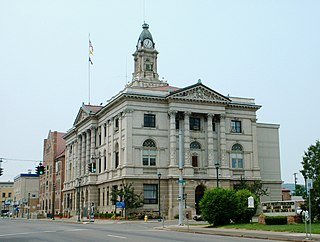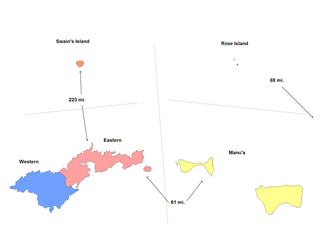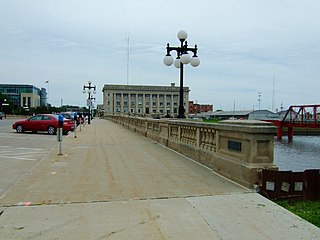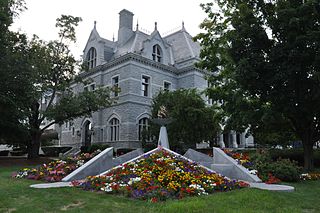
Elmira is a city and the county seat of Chemung County, New York, United States. It is the principal city of the Elmira, New York, metropolitan statistical area, which encompasses Chemung County. The population was 26,523 at the 2020 census, down from 29,200 at the 2010 census, a decline of more than 7 percent.

This is a list of the buildings, sites, districts, and objects listed on the National Register of Historic Places in American Samoa. There are currently 31 listed sites spread across the three districts of American Samoa. There are no sites listed on the unorganized atoll of Swains Island.

The Old Middletown Post Office, in Middletown, Connecticut, also known as the U.S. Post Office, was built in 1916. It was listed on the National Register of Historic Places (NRHP) in 1982. The building is also on the NRHP as a contributing property of the Main Street Historic District.

Downtown Santa Ana (DTSA), also called Downtown Orange County, is the historic city center of Santa Ana and the county seat of Orange County, California. It is the institutional center for the city of Santa Ana as well as Orange County, a retail and business hub, and has in recent years developed rapidly as a regional cultural, entertainment and culinary center for Orange County.
Henry C. Dudley (1813–1894), known also as Henry Dudley, was an English-born North American architect, known for his Gothic Revival churches. He was a founding member of the American Institute of Architects and designed a large number of churches, among them Saint Paul's Episcopal Cathedral in Syracuse, New York, built in 1884, and Trinity Church, completed in 1858.

The American Bank Note Company Building is a five-story building at 70 Broad Street in the Financial District of Manhattan in New York City. The building was designed by architects Kirby, Petit & Green in the neo-classical style, and contains almost 20,000 square feet (1,900 m2) of space, with offices and residences on the upper floors. The exterior consists of a main facade on Broad Street with two columns, as well as side facades with pilasters on Beaver and Marketfield Streets.

There are 73 properties listed on the National Register of Historic Places in Albany, New York, United States. Six are additionally designated as National Historic Landmarks (NHLs), the most of any city in the state after New York City. Another 14 are historic districts, for which 20 of the listings are also contributing properties. Two properties, both buildings, that had been listed in the past but have since been demolished have been delisted; one building that is also no longer extant remains listed.

The Spring Street Courthouse, formerly the United States Court House in Downtown Los Angeles, is a Moderne style building that originally served as both a post office and a courthouse. The building was designed by Gilbert Stanley Underwood and Louis A. Simon, and construction was completed in 1940. It formerly housed federal courts but is now used by Los Angeles Superior Court.

The U.S. Post Office–Lancaster Main is a historic post office at 120 Main Street in Lancaster, New Hampshire. Built in 1935, it is one of the few examples of Art Deco architecture in northern New Hampshire. The building was listed on the National Register of Historic Places in 1986.

The Greenwich Avenue Historic District is a historic district representing the commercial and civic historical development of the downtown area of the town of Greenwich, Connecticut. The district was listed on the National Register of Historic Places on August 31, 1989. Included in the district is the Greenwich Municipal Center Historic District, which was listed on the National Register the year before for the classical revival style municipal buildings in the core of Downtown. Most of the commercial buildings in the district fall into three broad styles, reflecting the period in which they were built: Italianate, Georgian Revival, and Commercial style. The district is linear and runs north–south along the entire length of Greenwich Avenue, the main thoroughfare of Downtown Greenwich, between U.S. Route 1 and the New Haven Line railroad tracks.

Buildings at 104–116 West Water St. were a set of historic commercial buildings located at Elmira in Chemung County, New York. They included a 3-story, four-bay building ; a 3+1⁄2-story, 14-bay Second Empire style building built about 1870 ; and a 2-story, five-bay Streamline Moderne building. The building at 104 W. Water was built in 1934 as an S. S. Kresge variety store.

Downtown Buckhannon Historic District is a national historic district located at Buckhannon, Upshur County, West Virginia. It encompasses 57 contributing buildings and one contributing structure that include the civic and commercial core of Buckhannon. Most of the buildings in the district date from the late-19th and early-20th century in popular architectural styles, such as Italianate, Queen Anne, Colonial Revival, and Classical Revival. Notable buildings include the Presbyterian Church on Locust Street (1879), T. L. Stockert Building (1908), Peoples Bank Building (1910), Upshur County Court House, and U.S. Post Office (1916).

Pierce & Bickford was an American architect partnership of Joseph H. Pierce and H. H. Bickford, based in Elmira, New York, that was active during 1890–1930.

The Civic Center Historic District is located in downtown Des Moines, Iowa, United States. It flanks both the Des Moines and Raccoon Rivers and their confluence. The district has been listed on the National Register of Historic Places since 1988. It is part of The City Beautiful Movement and City Planning in Des Moines, Iowa 1892—1938 MPS.

The Quitman Historic District is a 417-acre (169 ha) historic district located in Quitman, Georgia. It was placed on the National Register of Historic Places in 1982.

The U.S. Post Office, also known as the Berkeley Main Post Office, is a local branch of the United States Postal Service. The building, located at 2000 Allston Way Berkeley, California, was built in 1914-15.The building has been described as a "free adaptation of Brunelleschi's Foundling Hospital." Designed in the Second Renaissance Revival style, the front of the building features terra cotta arches supported by plain tuscan columns.

The Legislative Office Building of the New Hampshire State Legislature is a government office building across North State Street from the New Hampshire State House in Concord, New Hampshire. Built in 1889, it is one of the state's largest buildings built out of locally quarried granite. It was originally used as a post office and is listed on the National Register of Historic Places as the Old Post Office. It was also included in the Concord Civic District in 1983.

The Livingston Avenue Historic District is a historic district located along Livingston Avenue between Hale and Morris Streets in New Brunswick, Middlesex County, New Jersey. The district was added to the National Register of Historic Places on February 16, 1996, for its significance in architecture, social history, and urban history from 1870 to 1929. It has 58 contributing buildings and 2 contributing sites, including the Willow Grove Cemetery, the Henry Guest House, and the New Brunswick Free Public Library.

Maple Avenue Historic District is a national historic district located at Elmira, Chemung County, New York. It encompasses 121 contributing buildings and four contributing objects in a predominantly residential section of Elmira. It developed between about 1869 and 1940, and includes notable examples of Italianate, Second Empire, Queen Anne, Colonial Revival, and American Craftsman style architecture. Located in the district are the separately listed John Brand Jr. House, John Brand Sr. House, and Alexander Eustace House. Other notable buildings are the J.H. Harris House (1892), Samuel W. Clark House, James H. Clark House, and Horace W. Personius House (1913).
Clinton–Columbia Historic District is a national historic district located at Elmira, Chemung County, New York. It encompasses 83 contributing buildings in a predominantly residential section of Elmira. It developed between about 1860 and 1924, and includes notable examples of Greek Revival, Italianate, Second Empire, Queen Anne, Colonial Revival, and American Craftsman style architecture. Notable buildings include two sets of Italianate style row houses and two sets of Second Empire style row houses.






















